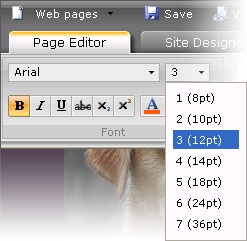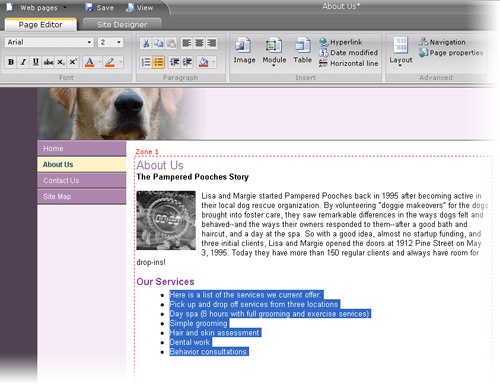After you get the text on the page, you may want to make a few changes. With the tools in the Font and Paragraph groups (which you may recognize from other applications, such as Microsoft Office Word 2007), you can change the look, color, format, and alignment of the text.
Note
What is a zone? The Page Editor displays each area of the page within a dotted red rectangle. Each rectangle is named and numbered as Zone 1, Zone 2, or Zone 3. You’ll learn more about zones and modules in Chapter 5, when you work with some of the more advanced Web features in Office Live Small Business.
Office Live Small Business includes placeholder text in each of the zones on the pages you work with. You can choose to preserve the format or change it to suit your own needs. Here’s how to change the look of the zone headings on your page:
Display the page you want to change.
Highlight the text you want to use as a heading.
Click the Font arrow and choose a font from the list.
Click Bold, Italic, or Underline as desired.
Click the Font Size arrow and choose a size from the list (see Figure 4-11).
Click the Font Color arrow and choose a color from the palette.
Tip
If you change the color of the heading on your page, be sure to choose a color that complements the colors that are already part of your site theme.
Figure 4-11. The font sizes in the Font Size list show both the HTML sizes and the more familiar point sizes for the text.
Note
Text sizes in HTML are shown in size levels ranging from 1 to 7, with 1 being the smallest and 7 being the largest. In print documents, text size is generally shown in points, a typographical term used to indicate the height of a character on a printed line. On the printed page, 72 points equals 1 inch, so a 72-point letter will be 1 inch tall.
Bulleted lists sometimes get a bad rap because everybody uses them—sometimes ad nauseum. But on the Web, when people are looking for information quickly, bulleted lists can be convenient, helpful, and efficient. What’s more, adding them is super easy. Here’s how to do it:
Select the text you want to turn into a bulleted list.
Click the Bulleted List tool in the Paragraph group.
Bullet characters are inserted automatically and the text is indented and aligned (see Figure 4-12).
Tip
In HTML, a bulleted list is coded as <UL>, which stands for unordered list. The list gets its name from the fact that the items in the list can appear in any order. In contrast, an ordered list, or <OL>, is the designation used for a list that must appear in a particular order. In Office Live Small Business, an ordered list is called a numbered list.


